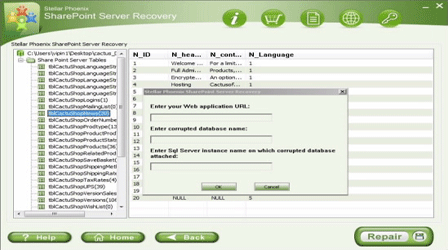SharePoint: Differential backup fails with error code 0xe0000363File Repair Tool Blog
Problem: Differential back or Log backups of Backup Exec database falls short displaying error as below:
Error code 0xe0000363: The Backup Exec SQL Agent wasn’t utilized to generate previous occupied, differential, or log backup of present database. You be required to make use of the SQL Agent in order to perform a full backup earlier than you can execute a transaction log backup or differential backup.
Cause behind error code:
This is mainly caused by Backup Exec database executing database safeguarding, which completes backup of database, separating differential or log backup and a Full backup.
Researchers after spending some time concluded that this boils down to LSN (Log Sequence Numbering) being modified by SQL. The malfunction happens when BE 2010 is tries to reference old LSN digits that’s been altered.
When any backup application and Backup Exec is used in combination (for example BESR 7.0 or SQL internal backup utility) then it might leave log backups or SQL Server differential un-retrieved, although log or differential backups displayed that they accomplished productively in job log.
This error takes place since Log Sequence Number (LSN) for SQL is retuned by additional backup program. So log backups or differential achieved by BEWS are relevant to additional backup program as a substitute of unique BEWS Full backup. Differential or log backups are therefore delivered unrecoverable by BEWS, for the reason that it’s not capable of using backup sets formulated by other backup program.
NOTE: Database safeguarding automatically operates at 4:00 AM daily by default. You can confirm this thing by verifying settings within Tools | Options | Database Maintenance.
Manual solution to fix error 0xe0000363
- Make certain no SQL backups sprint outside Backup Exec (counting SQL in-built utility for Backups and Retrieves) as that would disrupt continuity of SQL backups surrounded by Backup Exec program rooting the task to not succeed.
- Open SQL Management Studio. Find the way to Database within question.
- Right click on the Database, and then go to Reports > Standard Reports > Backup and Restore Events.
- Wait for reports to get retrieved and opt for Successful Backup Practices.
- Now you will be able to see a history of victorious backups of database. Note time and date, Backup Type, and Backup Name.
NOTE: The bedb.bak file is the database dump that’s generated in the course of every Database Maintenance period. Also BEDB database has straightforward recovery model which does not permit to carry out Log backup
Fully automatic solution to solve SharePoint error code 0xe0000363
SharePoint Server Repair Tool is professionally designed to repair corrupted or damaged SharePoint database or SQL server files and retrieve vital information. This tool helps you to perform a quick SharePoint repair and recover crucial or all content database related to particular Web application and its site collections. It allows administrators or users to extract stuffs like table, documents; media files labels, indexes, and other objects from remote MDF files.



Steps to repair SharePoint database
Step 1 – Download and Install SharePoint File Repair Tool on your system. Launch the software and you will see the interface and shown in the image below. You can select either ‘Complete Repair’ or ‘Document Recovery’.
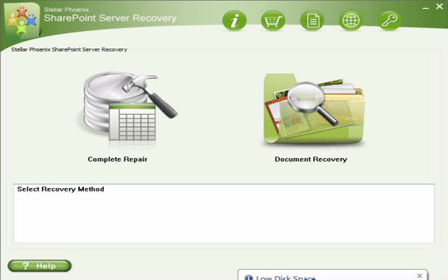
Step 2 – With ‘Complete Repair’, the screen shows options to select and find SQL Server (.MDF) files. Use ‘Search File’ option if you don’t know actual path of the database. Now click on ‘Scan’ to start scanning.

Step 3 – Once the scan process complete, the tool will create a tree of all SharePoint database tables will be demonstrated in the left pane. The sample will be in the right pane. Now click on ‘Repair’ to inaugurate repairing for preferred database.
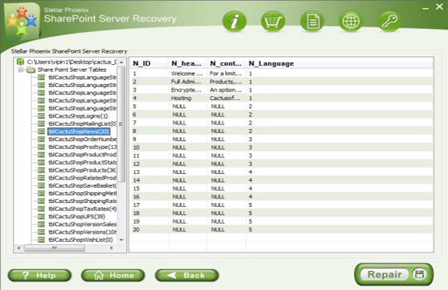
Step 4 – When you click on ‘Repair’, the below dialog box will get displayed. Specify the SQL Server name/Instance name and the desired destination path. Click Browse to select the destination path and click OK.
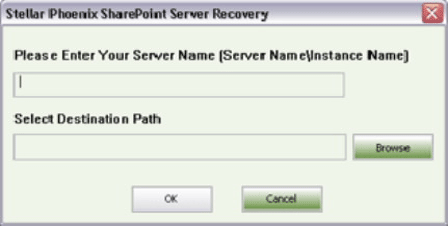
Step 5 – After completion of the process, a message will be displayed like ‘Recovered file saved at the desired location’. Now hit ‘OK’ button.
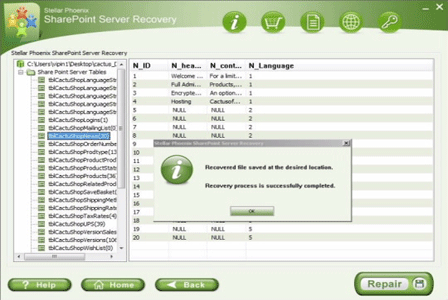
Step 6 – Another dialog box will ask you to attach repaired database to the web application. If you click ‘Yes’ button then below dialogue box will appear. Now enter application URL, name of the damaged database and SQL server instance name and then continue by pressing ‘OK’. When it’s done, repaired database will be available.
